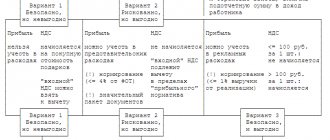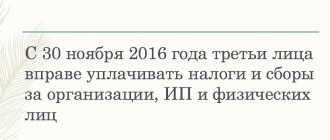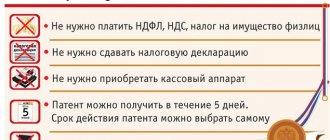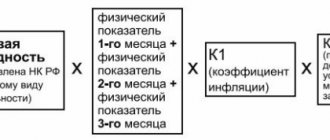What taxes does an individual entrepreneur pay on the simplified tax system in 2020 from employees - a complete list
In addition to the main tax - 15% for the simplified tax system "Profit" and 6% for the simplified tax system "Income" - individual entrepreneurs with employees in 2020 pay the following taxes for employees:
- Personal income tax – 13% from the salaries of residents and 30% from non-residents of the Russian Federation;
- Social contributions:
- OPS (22%);
- Compulsory medical insurance (5.1%);
- Social insurance (2.9%);
- Contributions for injuries and illnesses acquired at work (0.2-8.5%).
These taxes are paid as long as the entrepreneur is registered, regardless of whether he is active or not, whether he has income or not.
However, there are also concessions for some individual entrepreneurs. Thus, entrepreneurs engaged in the production of food and children's toys can save on payments.
In a number of regions, the 6% rate has been reduced to 1%, and the 15% rate to 5%.
Among the innovations of the year is an increase in tax holidays for a number of individual entrepreneurs on the simplified tax system. The conditions are: scientific, industrial or social field of activity of the entrepreneur, as well as the fact of opening an individual entrepreneur on the simplified tax system for the first time. The ability to take advantage of tax holidays depends, among other things, on the number of employees, the selected OKVED code and the level of annual profit of the individual entrepreneur.
Also, if the annual salary of your employees exceeds 711,000 rubles, then only 10% is transferred to the Pension Fund for the balance.
As for individual entrepreneurs with employees on the simplified tax system (Income): what taxes should they pay in 2020? The procedure and amounts of calculations for both types of simplified tax system are the same. But the possibility of reducing the rate due to insurance contributions varies.
Thus, an individual entrepreneur using the simplified tax system of 6% can deduct insurance payments for employees from the basic tax. The tax base can be reduced through contributions only during the period of payments.
For example, let’s take an individual entrepreneur with an income of 500,000 rubles. in year. For two existing employees, he transferred contributions in the amount of 60,000 rubles to the Federal Tax Service. The accrued single tax will be 30,000 rubles. (500 thousand x 6%). Since the individual entrepreneur has employees, he can reduce this tax by half. Those. He will transfer only 15,000 rubles to the budget.
Individual entrepreneurs using the simplified tax system (USN) can contribute 15% to expenses for employees. That's a plus. But the final tax cannot be reduced, so the savings in this case are less than with the simplified tax system of 6%.
For example, income for the 1st quarter for an individual entrepreneur of 15% was 250,000 rubles, and expenses were 180,000 rubles. The tax payment cannot be reduced by insurance contributions. They are already counted in expenses. The payment for the quarter will be 250,000 – 180,000 = 70,000 rubles. 70,000 * 15% = 10,500 rub.
Having correctly calculated the amount of taxes, it is important to pay them on time. We'll talk about the timing later.
The most accurate tax payment deadlines
The legislation of the Russian Federation establishes the following payment schedule for individual entrepreneurs on the simplified tax system with employees for 2020.
For advance payments, the reporting periods are the 1st quarter, half a year and 9 months of the year. Having received income in any of these periods, you must pay 6% or 15% on it no later than 25 days after the end of this period. For the calculation, the base (income or profit) for the entire current year is taken.
If there is no income or profit in the reporting period, there is no need to pay taxes. But if an entrepreneur has suffered losses, then he must make a minimum payment to the Federal Tax Service. For the simplified tax system of 6% it will be 6%, and for the simplified tax system of 15% it will be 1% of the total income.
The advance payment is taken in advance, but at the same time it makes it possible to reduce the total amount. Indicate these transfers in the annual declaration.
It should be noted that in 2020, sanctions for late payment of taxes have been tightened. A penalty of 1/300 of the refinancing rate of the Central Bank of the Russian Federation is charged daily for late payments. Serious violations may result in more serious fines or criminal liability.
A special line is personal income tax - a mandatory tax levied on employee salaries. What features need to be taken into account when calculating and paying it?
How much taxes does an employer pay for an employee?
Personnel are an irreplaceable resource for business. Without employees, it is very difficult to achieve real success. Personnel can be hired or engaged on the basis of a civil contract. Naturally, this raises the question: “How much taxes does the employer pay for the employee?”
The initial answer to this will be paradoxical: in accordance with the current legislation of the Russian Federation, the employer does not pay any taxes for employees. However, he is obliged to fulfill the duties of a tax agent for personal income tax and provide insurance for his employees and performers. We invite you to understand this difficult topic together.
What is personal income tax
Personal income tax is a tax on personal income. The person who received the income pays it at his own expense. In some cases, for example, when selling real estate and transport or when renting out an apartment, the responsibility to calculate and transfer personal income tax falls on the individual himself.
But if we are talking about income under an employment or civil contract, then the employer must withhold and remit the tax. In this case, he is a tax agent, a kind of intermediary between the employee and the budget. Moreover, violation of the duty of a tax agent is punished as strictly as failure to pay the tax itself (a fine of 20% of the unpaid amount).
The employer must give the employee his salary minus the withheld tax, i.e. Personal income tax is not paid from the funds of the organization or individual entrepreneur. This nuance must be taken into account when concluding a contract with an employee in order to avoid possible disputes. Indeed, often by the amount of wages an employee understands the amount that he will receive in his hands. And the employer means the size of the official salary before withholding personal income tax.
For example, the salary of a warehouse worker is 30,000 rubles. Let's calculate the personal income tax that the employer must withhold: (30,000 * 13%) = 3,900 rubles. This means that the worker will receive only 26,100 rubles. But in order for the amount she received to be 30,000 rubles, the contract must indicate that the official salary is 34,483 rubles.
The standard rate of personal income tax, which is withheld from payments to resident employees, is set at 13%. It should also be taken into account that a tax resident of the Russian Federation has the right to deductions, that is, a reduction in taxable income.
Most often, employees use the standard deduction for children. Let's assume that the employee in the example above has one minor child, so she is entitled to a standard deduction in the amount of 1,400 rubles. In this case, personal income tax is calculated as follows: (30,000 – 1,400) * 13%) = 3,718 rubles. The amount in hand is 26,282 rubles, i.e. 182 rubles more than without applying the standard deduction. This is not much, but it is expected that from 2020 the amount of the standard deduction for the first and second child will increase from 1,400 rubles to 2,500 rubles per month.
Features of personal income tax payment from experts
The simplified employer withholds income tax from the salaries of its employees. The timing of personal income tax payments varies depending on the type of income.
Thus, salary tax for an employee is transferred, as indicated above, the next day after salary payment. But for income in the form of bonuses and compensations - until the end of the month in which these payments were made.
Important! The employer must calculate personal income tax for each payment separately.
The tax is calculated using a formula in 3 stages. Let's consider an example for an individual entrepreneur with a rate of 13%
- Calculation of the tax base (NB) for personal income tax:
NB (beginning of the year) = Amount of income taxed at the rate of 13% (from the beginning of the year) – Amount of insurance deductions
- Tax calculation:
Personal income tax amount (from the beginning of the year) = NB (beginning of the year) x 13%
- Calculation of withheld personal income tax:
Personal income tax (current month) = Amount of personal income tax (from the beginning of the year) – personal income tax on income (from the beginning of the year to the previous month)
Example: employee Ivanova V.A. receives a salary of 35,000 rubles. She has a 5 year old son. The standard deduction for it is 1,400 rubles/month. In April, she received a bonus of 10,000 rubles. Based on these data, we determine the amount of deduction:
NB =35,000 x 4 months. + 10,000 rub. – (1,400 x 4 months) = 144,400 rubles.
Personal income tax amount for the 1st quarter = 144,400 rubles. x 13% = 18,772 rub.
Personal income tax for the first 3 months = (35,000 rubles x 3 months – (1,400 rubles x 3 months)) x 13% = 13,104 rubles.
Personal income tax for April = 18,772 rubles. – 13,104 rub. = 5,668 rub.
It should be noted that not all types of employee income are subject to personal income tax. Here is a list of payments on which tax is not paid:
- Payment upon dismissal (except for compensation for unused vacation and payments exceeding 3 months' salary);
- Payment to the family in the event of the death of a serviceman;
- A one-time payment upon the birth or adoption of a child;
- Payment for an employee moving to another location due to official duty;
- Travel expenses (no more than 700 rubles for trips within the Russian Federation and 2500 rubles for trips abroad);
- Cash compensation in case of natural disaster;
- Assistance to the employee’s family in the event of the death of a close relative;
- Compensation for the health of an employee, including a dismissed or retired employee.
Violation of the calculation procedure and deadlines for personal income tax payments entails penalties and criminal prosecution.
Violation of the deadlines for paying this tax, the absence of transfers to the Federal Tax Service or their incomplete amount entail a tax audit, fines and penalties, as well as an appeal to the prosecutor's office in case of malicious violations.
In 2020, the fine is 20% of the tax amount. If violations are permanent, the fine can reach 300,000 rubles. In some cases, imprisonment of up to 3 years is possible.
In addition to personal income tax, individual entrepreneurs and employees in 2020 pay taxes in the form of insurance contributions. What are the nuances of their payments this year?
How to calculate and transfer personal income tax from an employee’s salary for an individual entrepreneur
What taxes should an individual entrepreneur pay for employees? This question is often asked on our forum. How exactly it is necessary to calculate and transfer personal income tax when paying income to employees under employment contracts will be explained in this article.
In fact, the individual entrepreneur does not pay any taxes for employees; he only withholds personal income tax (NDFL) from the salary he issues. Moreover, he withholds and transfers it to the budget, and does not pay at his own expense. It's called a tax agency. The basic tax rate is 13%. There are other rates, but they either do not apply to payments to employees, or for those citizens who spend less than 183 days a year in Russia. All personal income tax rates can be found in Article 224 of the Tax Code.
From what income of an individual entrepreneur must the personal income tax be withheld?
Tax must be withheld from almost all income paid to an employee. Salaries, bonuses, vacation pay, and even temporary disability benefits (sick leave) are subject to personal income tax. Exceptions are listed in Article 217 of the Tax Code, but there is little that concerns employers there, except perhaps maternity and child care benefits. But in many regions the Social Insurance Fund now pays them directly to citizens, bypassing employers.
How is the base for calculating the tax and the tax itself calculated?
The tax base is considered an accrual total. What is a running total? This is when the result of the previous month is taken into account in the next month.
Example: the salary of an individual entrepreneur is 30,000 rubles. We calculate the tax for March: add up the salary for three months Z0000 30000 30000 = 90000 rubles; multiply the base by the tax rate of 13% 90000×13%=11700 rubles; we subtract the amount of personal income tax that was withheld from the salary for January and February and we get a tax that must be transferred to the budget 11700-7800 = 3900 rubles.
Why can’t you count separately by month, you ask? Because the tax period for personal income tax is one year, and the income paid is not always in such round figures. Taking into account the fact that personal income tax is not calculated and paid in kopecks, the ruble may move around here and there. Because of this, the reporting and the transferred tax will not match, which may lead to the accrual of penalties, and this is completely unnecessary.
Note! Personal income tax does not come with pennies. A tax amount of less than 50 kopecks is discarded, and a tax amount of 50 kopecks or more is rounded up to the full ruble.
How to apply tax deductions?
When calculating personal income tax, an employee may be entitled to deductions - standard (Article 218 of the Tax Code), social (Article 219 of the Tax Code) or property (Article 220 of the Tax Code).
Most often, a standard deduction is provided for children:
- 1,400 rubles - for the first child;
- 1,400 rubles - for the second child;
- 3,000 rubles - for the third and each subsequent child;
- 2,000 rubles - for each child if a child under the age of 18 is a disabled child, or a full-time student, graduate student, resident, intern, student under the age of 24, if he is a disabled person of group I or II.
Standard deductions are provided at the request of the employee and until his income from the beginning of the year exceeds 350 thousand rubles, or until his children reach an age that no longer gives the right to a deduction. If an employee comes to an individual entrepreneur in the middle of the year, you need to ask him for a 2-NDFL certificate from his previous place of work in order to know whether the person has the right to deductions or whether he has already received an income of 350 thousand rubles. and the deduction is no longer allowed.
Example: an employee’s salary is 30,000 rubles. He has two children and he wrote an application for deductions. He will be able to receive deductions for January-November. There will no longer be a deduction for December, because income for January-December will be 360,000 rubles.
When calculating the deduction tax, the tax base is reduced, and also on an accrual basis:
Example: we calculate wages for the month of March if the employee has two children. Taxable base for 3 months is 90,000 rubles, standard deductions for three months (1400 1400) x 3 = 8400 rubles. 90000-8400=81600×13%=10608 rub. You subtract the personal income tax withheld from the employee for January and February and get the amount of tax that must be withheld for March and transferred to the budget.
When to withhold and transfer personal income tax?
Personal income tax from wages must be withheld and transferred once a month. Tax is not withheld from advance payments (and salaries must be paid at least twice a month!).
Personal income tax is calculated on the last calendar day of the month, and the salary due for the entire month, including the advance payment, is considered. Personal income tax calculated for the past month is withheld upon the first payment of wages.
As a general rule, personal income tax must be transferred to the budget no later than the next business day after payment of income.
Example: employee’s salary is 30,000 rubles. On January 20, he was paid an advance in the amount of 13,000 rubles. Personal income tax is not calculated on January 20 and is not transferred to the budget. As of January 31, the tax base and personal income tax from it are calculated: 30,000 × 13% = 3,900 rubles. On February 5, the employee is paid a salary for January, taking into account the previously paid advance of 30,000-3,900-13,000 = 13,100 rubles. Personal income tax in the amount of 3900 is transferred to the budget no later than the next working day after payment.
Note! There is no concept of advance in the Labor Code. According to it, salaries must be paid at least every half month. It’s just that the word advance is more familiar to employers and employees themselves.
It is impossible to transfer personal income tax before it is withheld. Payment of tax at the expense of a tax agent is prohibited (except for the case when personal income tax is additionally assessed by tax authorities during an audit). You should not calculate personal income tax before the last day of the calendar month.
If an individual entrepreneur pays vacation and sick leave, then personal income tax on these payments is withheld on the day they are paid. Those. the employee receives vacation pay minus tax. But personal income tax is transferred to the budget no later than the last day of the calendar month in which such payments were made
In this case, both vacation pay (sick leave) and personal income tax from them will be taken into account when calculating the tax for this calendar month:
Example: an employee was ill for three days in January and was paid temporary disability benefits on January 25 in the amount of 668-87 (personal income tax) = 581 rubles. Personal income tax was paid on January 26. In addition, the employee received an advance payment of 13,000 on January 20. We calculate personal income tax for January: 24,700 (salary for a month not fully worked) 668 (sick leave) = 25,368 × 13% = 3,298 rubles. On February 5, the employee receives a salary of 24700-13000-3211 = 8485 rubles. On February 6, the withheld personal income tax of 3,211 rubles is transferred to the budget. (RUB 3,298 minus RUB 87 previously paid)
Where and how to transfer personal income tax
Individual entrepreneurs on OSNO, simplified tax system and unified agricultural tax pay personal income tax for the employee at the place of their registration as an individual entrepreneur. And it doesn’t matter where he operates.
Individual entrepreneurs who work for PSN or UTII pay personal income tax for employees at the place of registration. But only if these employees participate in activities that are subject to PSN or UTII.
Insurance premiums for employees in 2020 for individual entrepreneurs using the simplified tax system
Social contributions for yourself and employees are made separately. We have indicated above in what amount and within what time frame they are paid. In this part of the article, we will describe the nuances of calculating and paying this type of taxes from employees this year.
Let's start with the pleasant stuff right away. It is possible to reduce insurance premiums if all 3 conditions are met:
- The type of activity of an individual entrepreneur belongs to preferential ones (IT companies; NPOs on the simplified tax system in the field of social services, science, education, medicine, culture, mass sports; charitable foundations, etc.);
- Annual revenue does not exceed 70%;
- Annual turnover does not exceed 79 million rubles.
Also, insurance premiums in our country are subject to maximum fees. In 2020, for pension insurance - 1,021,000 rubles, but for accidents - 815,000 rubles. When an employee’s income reaches the specified amounts, reduced tariffs are applied to insurance premiums: for the Pension Fund of the Russian Federation - 10% of the excess amount and for the Federal Tax Service - 0%.
When the limit is reached, the payment of insurance premiums for employees in 2019 for individual entrepreneurs using the simplified tax system stops.
The only exception is medical insurance - the fee for it is 5.1% of the salary in any case.
When working in hazardous working conditions, additional deductions for injuries are charged. The rate is determined by the OKVED type.
Fees are calculated individually for each employee. And payment is made in the total amount.
For late payment, incorrect calculation, non-payment or incomplete payment, the entrepreneur is subject to a fine of 20–40% of the amount of due contributions, as well as a penalty in the amount of 1/300 of the refinancing rate for a delay of up to 30 days and 1/150 for a delay of more than 30 days. days.
For debts exceeding 15,000,000 rubles. criminal liability arises.
To avoid fines, you need to:
- Transfer personal income tax to the Federal Tax Service on the day employees are paid;
- Transfer insurance payments by the 15th day following the current month;
- Keep documents confirming the correctness of tax calculations;
- Calculate payments to funds for a specific type of insurance and employee individually without rounding;
- When transferring funds to funds, carefully indicate the KBK;
- Complete and submit reports carefully.
These simple rules will help prevent, for example, a situation that happened to one entrepreneur. The story is below.
Taxes and payments for individual entrepreneurs in 2020
Home / Other
All taxes, fees, contributions and other payments that individual entrepreneurs are required to pay can be divided into 4 groups:
Taxes according to the chosen taxation system
| Tax regime | Tax | Bid,% | Deadline for paying taxes to the budget |
| BASIC | VAT | 0, 10, 18 | Until the 25th day (inclusive) of each month following the past quarter, 1/3 of the amount monthly or in one payment until the 25th day (inclusive) of the month following the past quarter |
| Personal income tax | 13, 30 | Until July 15 (inclusive) of the year following the reporting year | |
| Property tax for individuals | 0.1-2 (set by constituent entities of the Russian Federation) | For the year before December 1 of the year following the reporting year | |
| simplified tax system | Single tax | 6 (from income), 15 (income minus costs) *rate may be lower | Based on the results of the reporting period (Q1, half-year, 9 months, year) until the 25th day (inclusive) of the month following the end of the billing period For a year – until April 30 (inclusive) of the next year |
| Property tax (on objects at cadastral value used in conducting business) | 0.1-2 (set by constituent entities of the Russian Federation) | For the year before December 1 of the year following the reporting year | |
| UTII | A single tax on imputed income | By calculation method, depending on the region and physical. indicators | Until the 25th day (inclusive) of the month following the reporting quarter |
| Property tax (on objects at cadastral value used in conducting business) | 0.1-2 (set by constituent entities of the Russian Federation) | For the year before December 1 of the year following the reporting year | |
| PSN | Patent cost | 6 (from potential income) *rate may be lower | If the validity period is less than 6 months - a one-time payment no later than the expiration date of the patent For a period of 6-12 months - 1/3 within 90 days from the beginning of the patent term, 2/3 no later than the end of this period |
| Unified agricultural tax | Unified agricultural tax | 6 (from income minus expenses) *rate may be lower | Advance payment – no later than 25 days after the end of the six months One year – until March 31 (inclusive) of the next year |
| Individual entrepreneurs on OSNO and simplified tax system, trading in the region** where the law on trade tax has been adopted | Trade fee | By calculation method, depending on the regional rate** and parameters of the trade item | Quarterly until the 25th day (inclusive) of the month following the reporting quarter |
Note:
*regional authorities of the constituent entities of the Russian Federation have the right to independently reduce tax rates under the simplified tax system, PSN and unified agricultural tax within the framework of tax holidays;
**Currently, such a regulatory document has been approved only for Moscow (law dated December 17, 2014 No. 62); in other regions, the trade tax has not yet been introduced.
Other taxes and fees
An entrepreneur may engage in certain types of activities that require the payment of additional taxes, and also have licenses or permits that oblige him to pay special fees and charges.
In this case, additional taxes and fees are paid by individual entrepreneurs regardless of the chosen tax regime.
| Taxes | Tax on the production and sale of excisable products |
| Transport tax | |
| Water tax | |
| Land tax | |
| Mineral extraction tax | |
| Fees and Payments | Water fees |
| Fee for the use of wildlife objects | |
| Regular payments for subsoil use |
Taxes and contributions on employee remuneration
An individual entrepreneur can use the labor of hired individuals by concluding employment or civil law contracts with them (provision of services, contracts, etc.).
By attracting hired employees, an individual entrepreneur assumes the responsibilities of a tax agent and incurs additional costs for paying contributions for his workers:
- An entrepreneur is obliged to calculate and withhold personal income tax on employee income (in the amount of 13% from remunerations of residents or 30% from foreigners) and transfer it to the budget no later than the next day from the date of payment of income.
- An individual entrepreneur must pay the following types of contributions from employee benefits:
| Supervisory authority | Type of contribution | Bid,% |
| Inspectorate of the Federal Tax Service | OPS (pension insurance) | 22 |
| Compulsory medical insurance (health insurance) | 5,1 | |
| SSS (social insurance and security) | 2,9 | |
| FSS | Injuries (occupational diseases and industrial accidents) | 0,2-8,5 Set by the fund depending on the type of activity |
Contributions must be paid monthly until the 15th day (inclusive) of the month following the billing month.
Note: it should be taken into account that if personal income tax is paid directly from the income of the employees themselves, then individual entrepreneurs pay contributions for their employees from their own funds. Such an obligation is imposed on the entrepreneur by law, as an employer.
Fixed contributions for individual entrepreneurs
Each entrepreneur must pay fixed insurance contributions to the budget for himself for compulsory pension and health insurance.
Moreover, the merchant is obliged to pay such contributions when applying any tax regime, regardless of the fact of making a profit, and even provided that no economic activity was carried out at all.
Since 2020, insurance payments are no longer tied to the minimum wage and are (for the current year):
OPS – 26,545 rub.
Compulsory medical insurance – 5,840 rubles.
Previously (until 2020), the amount of contributions was calculated depending on the minimum wage established at the beginning of each year, according to the formula:
| OPS | Minimum wage * 26% * 12 months. |
| Compulsory medical insurance | Minimum wage * 5.1% * 12 months. |
An individual entrepreneur can pay contributions for himself in installments or repay them in a lump sum, the main thing is to pay the full amount to the budget before December 31 of the current year.
If the annual income of an individual entrepreneur exceeds 300,000 rubles, you must additionally pay 1% of the excess amount to the budget. The deadline for paying such a contribution is July 1 of the following year.
Did you like the article? Share on social media networks:
- Related Posts
- Individual entrepreneur reporting in 2020
- Insurance premiums for employees in 2020
- Application for transfer of vacation
- Liquidation of an LLC in 2020: step-by-step instructions
- Tax holidays for individual entrepreneurs in 2020
- Personal income tax for employees (income tax)
- Budget classification code (BCC): table
- LLC reporting in 2020
Discussion: 2 comments
- Zania:
04/17/2018 at 18:10Is it possible to take PSN in Tatarstan? When to do this if the registration of an individual entrepreneur is from 04/12/2018. And are “tax holidays” accepted in Tatarstan for new entrepreneurs?
Answer
Alexei:
04/18/2018 at 12:26
Hello. No, tax holidays are not accepted in Tatarstan. You can see how to obtain a patent by clicking on the “PSN” link in the table above “Taxes according to the selected taxation system.”
Answer
Leave a comment Cancel reply
Personal history of the taxpayer
“You can’t do a foreign language school without hired workers. As the owner of the organization, I had to hire a visiting accountant. He did all the accounting for employees, but did not sit in the office. It was inconvenient to resolve urgent issues with him, but for me it was the cheapest option for maintaining personnel records.
All accounting documents were permanently stored in the office. For the time being everything was fine. Until we moved to another building.
During the move, some of the documents got lost somewhere. And as luck would have it, the tax office came with an audit. You understand, without paperwork it turned out to be impossible to prove that we pay taxes for our employees in full. I was fined well.
This was not my accountant’s fault, of course. But I still had to refuse to cooperate with him. True, for a different reason. Only after a year of working with him, I learned that reduced insurance premiums can be applied to my type of activity according to OKVED. I would save a lot of money.
Now I trust only professionals. Hired a full-time accountant. Even if it costs me dearly, I am sure that my accounting is always in order, there are no unpleasant surprises waiting for me, and I do not risk losing my money.”
Now you know what taxes an individual entrepreneur pays on the simplified tax system in 2020 from employees. If you liked the article, save it on your social network page so as not to lose it. This way you will have up-to-date information at your fingertips. Also sign up for our newsletter for business owners and accountants. All our subscribers receive the latest information, taking into account the latest changes in the field of accounting and taxation.








